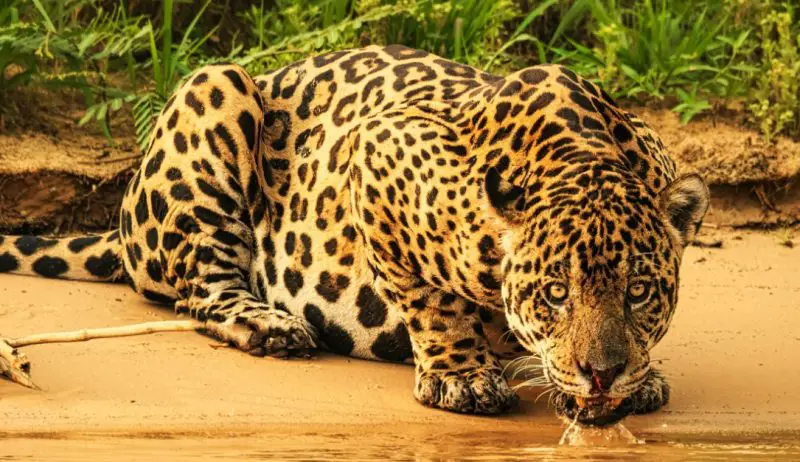Arizona’s desert is a harsh and unforgiving environment — marked by scorching daytime heat, limited water, and sparse vegetation. It might seem an unlikely place for a large apex predator like the jaguar, known for inhabiting dense tropical forests and jungles, to survive.
Yet, despite these challenges, jaguars have persisted in the deserts of southern Arizona for centuries. This remarkable survival story reveals much about the adaptability and resilience of this magnificent big cat.
The Jaguar’s Historical Presence in Arizona

Jaguars (Panthera onca) are the largest cats native to the Americas and historically ranged from South America all the way up into the southwestern United States. Fossil evidence and historical accounts confirm that jaguars once roamed across Arizona’s desert landscapes, as well as parts of New Mexico and Texas. Although their populations have drastically declined due to habitat loss and human persecution, sightings and confirmed presences in recent decades have reignited interest in understanding how these cats have managed to survive in such an extreme environment.
The jaguar’s survival in Arizona is intertwined with the unique desert ecosystem it inhabits and the jaguar’s extraordinary adaptability. Unlike the dense rainforests typically associated with jaguars, the Sonoran Desert and adjoining mountain ranges provide a mosaic of habitats that jaguars have learned to navigate and utilize effectively.
Adaptations That Enable Jaguars to Thrive in Arid Conditions
Physical Adaptations for Desert Survival
Jaguars possess physical characteristics that aid them in coping with Arizona’s desert conditions. Their robust, muscular build helps them manage long hunts and traverse rugged terrain. Their short, tawny coats with distinctive rosettes serve as camouflage in the desert’s dappled light—especially in areas with scrub brush, rocky outcrops, and shadowed canyons.
Unlike many desert animals adapted for extreme heat by being small or light-colored, jaguars maintain a dense, short fur that provides protection from the sun and helps regulate body temperature. This fur also offers a barrier against the thorny desert vegetation and insect bites.
Jaguars have powerful jaws and large canine teeth, enabling them to take down a wide variety of prey. This flexibility is crucial in a desert environment where prey availability can fluctuate significantly.
Behavioral Adaptations to Desert Life
Beyond their physical traits, jaguars in Arizona have developed behavioral strategies to survive the intense desert heat and scarcity of resources. They tend to be primarily nocturnal or crepuscular—active during dawn, dusk, and nighttime when temperatures drop, reducing the risk of overheating.
Jaguars are also adept swimmers, an unusual trait for desert animals but one that benefits them in the riparian corridors that snake through the arid landscape. These watercourses provide cooler microhabitats, hunting grounds, and vital hydration sources. Jaguars take advantage of these oases, which are scattered but crucial within the desert.
Their solitary and elusive nature helps jaguars avoid human contact, reducing the risk of conflict and allowing them to occupy territories large enough to support their needs. They are territorial animals that mark their ranges carefully but also adjust their movement patterns seasonally based on prey availability and water access.
Prey Availability and Jaguar Diet in the Desert
Diversity of Prey in the Sonoran Desert
One key to the jaguar’s survival in Arizona’s desert lies in its ability to exploit a wide variety of prey species. Jaguars are opportunistic hunters and do not specialize on a single type of animal. While in tropical forests their diet often includes capybaras, peccaries, and monkeys, desert jaguars rely on animals adapted to arid conditions.
The Sonoran Desert hosts a surprising diversity of mammals, birds, and reptiles that serve as prey. Mule deer, javelinas (collared peccaries), and desert bighorn sheep are among the larger prey items. Smaller mammals such as rabbits, rodents, and ground-dwelling birds also form part of their diet, especially when larger prey is scarce.
Jaguars’ powerful build allows them to ambush and overpower relatively large animals, but their flexible hunting behavior means they can also adjust to hunt smaller or more elusive prey. This dietary flexibility is essential for enduring the fluctuating availability of food in the desert environment.
Hunting Techniques in a Challenging Environment
The jaguar’s hunting techniques in Arizona’s desert display their remarkable adaptability. Unlike the stealthy stalk-and-pounce approach used in forests, desert jaguars often rely on ambush tactics around waterholes and riparian zones where prey congregates. These locations concentrate prey animals, making ambush more effective.
The rugged terrain of the desert also provides numerous natural cover points for stalking prey, including rocky cliffs, caves, and dense vegetation clusters. Jaguars use their acute senses of sight and hearing to detect prey movement even in sparse cover.
Additionally, jaguars are powerful swimmers and can hunt aquatic or semi-aquatic animals such as fish, turtles, and even caimans in some regions. In Arizona, rivers and streams support such prey, offering additional food sources that many desert predators cannot access.
Water and Hydration Strategies
Water scarcity is a defining challenge of desert life. For many animals, survival depends on maximizing water intake while minimizing water loss. Jaguars have adapted by utilizing several strategies to maintain hydration.
Firstly, jaguars often get much of their water from the prey they consume. Prey animals such as deer and peccaries contain significant body fluids that can help sustain the jaguar. This metabolic water intake lessens their direct dependence on standing water sources.
Secondly, jaguars carefully select their habitat near riparian corridors, springs, or watering holes, which provide direct water access. These areas are lifelines within the desert, often surrounded by denser vegetation and cooler microclimates, offering relief from the harsh sun.
Lastly, jaguars are mostly active during cooler parts of the day or night, reducing water loss through panting or sweating. Their thick fur also aids in temperature regulation, preventing excessive evaporation from their skin.
Habitat and Range: Navigating the Arizona Desert Landscape
The Role of Mountain Ranges and Riparian Areas
Arizona’s desert environment is not a flat, uniform expanse but a complex mosaic of habitats shaped by elevation, water availability, and vegetation types. Mountain ranges such as the Sky Islands create cooler, forested habitats that contrast sharply with the surrounding desert floor. These islands of biodiversity provide refuge for jaguars and their prey.
Riparian areas, such as the Santa Cruz River and other perennial or intermittent streams, create linear corridors of lush vegetation. These corridors support higher prey densities and offer shade and cover critical for jaguars’ hunting and resting needs.
Jaguars in Arizona often utilize these mountain and riparian habitats extensively. Their large territories may span across desert lowlands, foothills, and forested highlands, demonstrating their capacity to move across diverse ecological zones.
Movement Patterns and Territory Size
Because prey and water are patchily distributed in the desert, jaguars in Arizona tend to have very large home ranges compared to those in more resource-rich tropical forests. These territories allow them to access sufficient food and water throughout the year.
Jaguars are capable of traveling long distances and often move nocturnally to avoid the heat and human disturbances. Their movement corridors often follow natural landscape features such as ridges, riverbanks, and valleys.
Their solitary and territorial behavior helps reduce intraspecies competition, which is vital in an environment where resources are limited. This social structure, combined with their adaptability, helps maintain stable jaguar populations even when numbers are low.
Human Impact and Conservation Challenges
Threats to Jaguars in Arizona’s Desert
Despite their impressive adaptability, jaguars face numerous challenges in Arizona’s desert. Habitat fragmentation due to urban development, highways, and agriculture isolates jaguar populations and restricts their movement corridors.
Human-wildlife conflicts, including livestock predation concerns and illegal hunting, further threaten jaguars. Although jaguars are protected under various federal and state laws, enforcement and public awareness remain crucial to their survival.
Climate change also poses long-term risks by altering water availability and prey distributions in the desert. Prolonged droughts could intensify the challenges jaguars face, making conservation efforts even more urgent.
Conservation Efforts Supporting Jaguar Survival
Several conservation programs have been established to protect jaguars in the U.S. Southwest, including Arizona. These efforts focus on habitat preservation, corridor creation, scientific monitoring, and public education.
One key approach involves securing and restoring riparian habitats and Sky Island mountain forests, which are critical for jaguar survival. Efforts to connect isolated jaguar populations through wildlife corridors aim to maintain genetic diversity and allow natural movement.
Research initiatives use camera traps, GPS collars, and genetic analysis to track jaguar populations and better understand their habitat use. These data help tailor conservation strategies to the jaguar’s specific needs in the desert environment.
Community outreach and coexistence programs also play a vital role by educating local residents and landowners about jaguars, reducing conflicts, and promoting practices that safeguard both wildlife and human interests.
The Jaguar’s Future in Arizona’s Desert
The survival of jaguars in Arizona’s desert is a testament to nature’s resilience and the cat’s remarkable adaptability. Their continued presence in this extreme environment challenges conventional notions about jaguar habitats and expands our understanding of their ecological flexibility.
However, their future remains uncertain. As human pressures and climate shifts intensify, maintaining and enhancing suitable habitats will be critical. This requires ongoing commitment from conservationists, government agencies, local communities, and researchers.
Protecting jaguars in Arizona not only preserves a charismatic apex predator but also safeguards the broader desert ecosystem. Jaguars help regulate prey populations and maintain ecological balance, making their survival vital for desert biodiversity.
The jaguar’s journey through Arizona’s desert is an inspiring example of survival against the odds—a powerful reminder of the importance of coexistence and stewardship in preserving the wild heart of the American Southwest.
FAQs About Jaguars in Arizona
What makes the Arizona desert suitable for jaguars?
Despite its harsh conditions, Arizona’s desert offers diverse habitats such as riparian corridors and mountainous areas that provide essential water, prey, and shelter for jaguars.
How do jaguars find water in such an arid environment?
Jaguars obtain moisture from the prey they consume and rely on limited but vital water sources like streams, springs, and watering holes scattered throughout desert riparian zones.
What kind of prey do jaguars hunt in Arizona?
Jaguars in Arizona hunt mule deer, javelinas, desert bighorn sheep, rabbits, and various smaller mammals and birds, adapting their diet to the desert’s available wildlife.
How do jaguars avoid the desert heat?
They are mostly nocturnal or active during dawn and dusk, avoiding the hottest daytime hours to better regulate body temperature and conserve water.
Are jaguars endangered in Arizona?
Yes, jaguars are rare and considered endangered in the United States, facing threats from habitat loss, fragmentation, and human conflicts despite ongoing conservation efforts.
How large are jaguar territories in Arizona compared to other regions?
Because resources are patchily distributed in the desert, jaguars in Arizona maintain larger home ranges than their tropical forest counterparts to secure enough prey and water.
What conservation efforts support jaguar survival in Arizona?
Conservation programs focus on habitat protection and restoration, creating wildlife corridors, monitoring populations, and educating local communities to promote coexistence.






